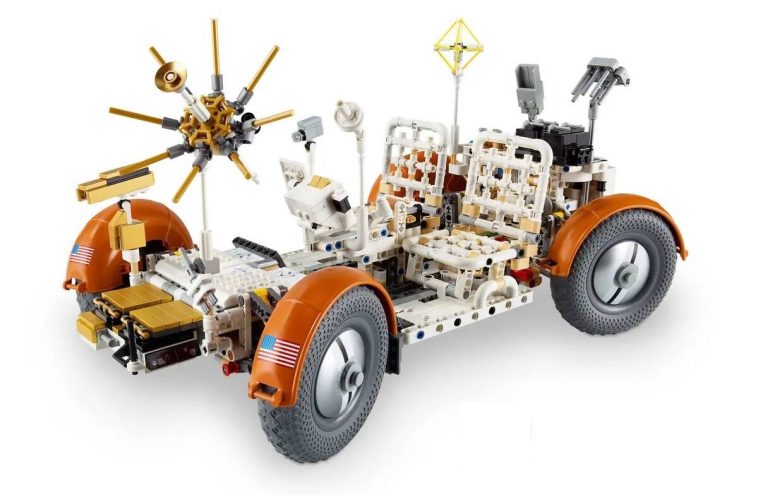The original Apollo Lunar Roving Vehicle had the look of something that had been strung together from an oversized Meccano set. It should, therefore, not come as a surprise to find a LEGO variant built from the company’s Technic pieces.
Lego Lunar Roving Vehicle (pic credit: Lego) – click to enlarge
The Register has assembled plenty of space-based Lego sets over the years, including official Apollo-based items from Lego itself to sets designed by enthusiasts. All were a delight to construct, particularly when you stir in some of the accuracy improvements that can be applied to retail sets, or build designs that really should be on retail shelves.
Lego Lunar Roving Vehicle and an unofficial minifig-scale version – click to enlarge
The Lunar Roving Vehicle (LRV), in Apollo 17 spec, is the latest in Lego’s line and is, without wishing to jump to the conclusion too early, a superb effort from the brick maker. With one, glaring, exception. But we’ll get to that later.
The set itself is constructed from Technic pieces, much like the Mars rover. We’d argue that Technic is a much better fit for a recreation of the spindly LRV, and Lego has pulled out all of the stops when it comes to playability. Want to do some steering? Sure – there are four-wheel and two-wheel modes. How about folding it up, as though ready to be deployed from the lunar module’s descent stage? Absolutely, fold the seats and wheels, and you’re good to go.
Just as the actual LRV was a marvel of engineering, so Lego’s recreation is an impressive feat of what can be achieved with Technic.
NASA’s LRV was flown on the Apollo 15, 16, and 17 missions during 1971 and 1972. It was designed to fold up and fit into the lunar module’s descent stage and, powered by battery, could ferry two astronauts, their equipment, and samples around the Moon.
The fastest (unofficial) speed recorded for the vehicles was 18 km/h during Apollo 17, and the vehicle went 35.9 km over the course of its three traverses during the mission. According to NASA, the farthest it went from the lunar module was 7.6 km; planners had to take care to ensure astronauts remained within walking distance of their spacecraft in the event the LRV failed.
There are 1,913 pieces in Lego’s set – not a historic number from what we can see – split into bags, some made of paper, some of plastic. There is also a hefty instruction booklet and the usual array of irritating stickers that are found in all too many Lego sets.
Assembly was straightforward, and you can expect to spend about eight hours fiddling with Technic. We’d strongly recommend reading ahead in the booklet – there were at least two occasions where we could have been left weeping in frustration if not for knowing what the instructions were leading towards.
The LRV itself was completed ahead of its payloads: Lego includes the Lunar Communications Relay Unit (LCRU); the aft pallet assembly – with tools and scientific equipment; and the forward chassis, which sports a recreation of Apollo 17’s color television camera and the high-gain antenna along with batteries. Plenty of creative license has been taken, but most of it won’t worry the majority of builders.
However, it is with the high-gain antenna that the wheels come off this set slightly. Despite the attention to detail elsewhere – yes, this has already been improved by enthusiasts – the high-gain antenna represents the most egregious diversion from what is currently sitting on the Moon.
The original was a deployable parabolic antenna, which used a fine mesh to create a dish. Lego has opted to dispense with this dish, leaving just the arms to illustrate where the dish should be. It’s a jarring omission and would be unforgivable if not for the quality of the rest of the set.
We asked Lego why it did not create a custom part for the dish, but the company had no comment to make.
As with many of Lego’s space sets, enthusiasts tackling the issue, but it’s a shame that Lego could not include something in the box.
Shackleton’s Endurance sets sail for polar peril in Lego
$373M ASML chipmaker shrinks to $228 – but it’s made of Lego
The Reg builds official Lego Artemis and Milky Way sets
A Raspberry Pi HAT for the Lego Technic fan
The various components in the set sparked discussion, and there are plenty of easter eggs hidden away and moveable elements to engage otherwise disinterested participants.
Lego’s Lunar Roving Vehicle set is a delight to assemble. Yes, it can be a bit tricky in places – this is Technic, after all – but it is also eminently playable and an eye-opener into just how creative the engineers in the days of Apollo were when it came to maximizing space.
It doesn’t come cheap at £189.99 in the UK or $219.99 in the US, yet it is a worthy addition to Lego’s space series. ®





GIPHY App Key not set. Please check settings